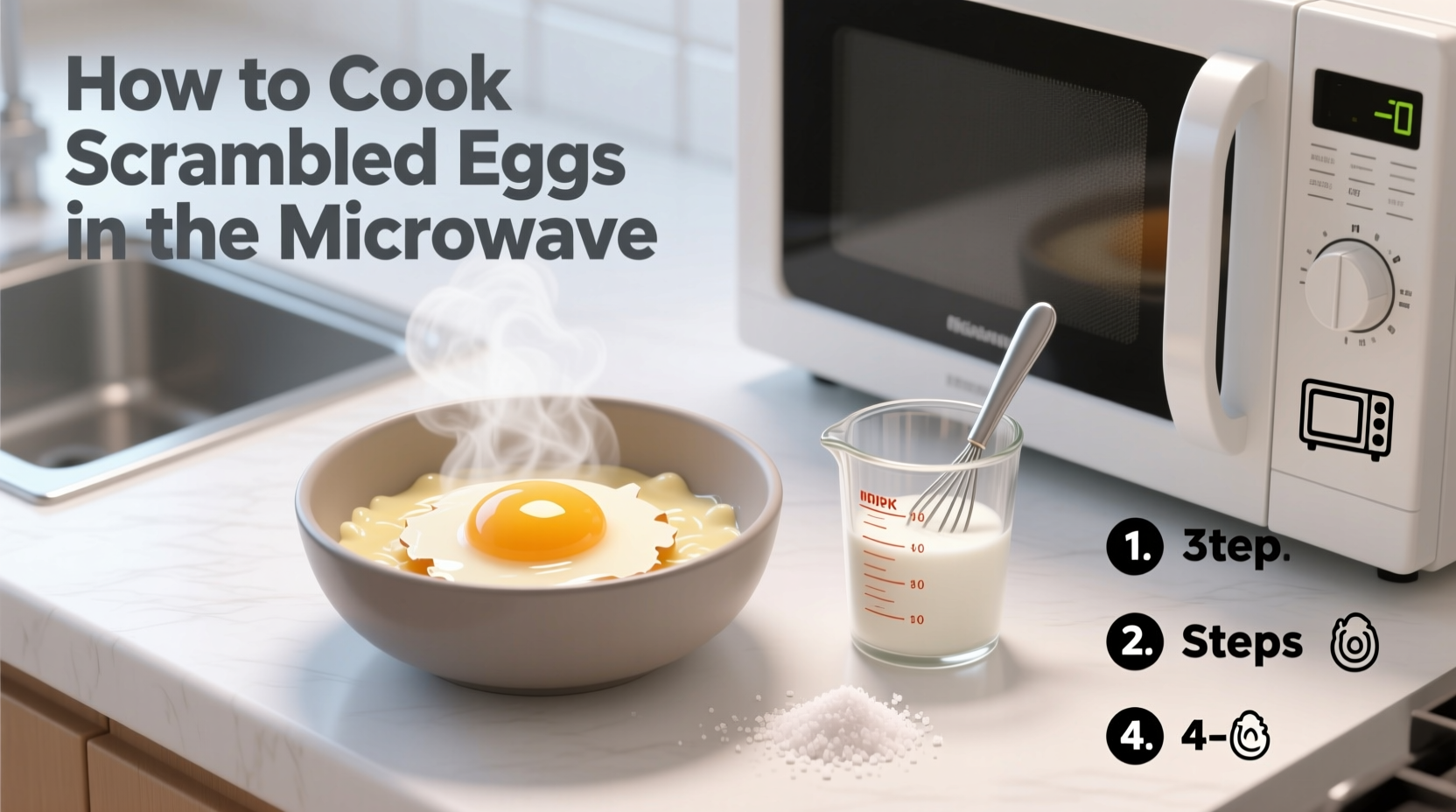Yes, you can make perfect scrambled eggs in the microwave in just 2-3 minutes with this simple method: Whisk 1-2 eggs with 2 tablespoons of milk or water, microwave in 30-second intervals while stirring between each burst, and stop cooking when slightly underdone as residual heat will finish the process. This foolproof technique yields fluffy, restaurant-quality scrambled eggs without any special equipment.
The Smart Way to Make Microwave Scrambled Eggs
When you're pressed for time but still want a protein-packed meal, microwave scrambled eggs deliver restaurant-quality results in minutes. Unlike stove-top methods that require constant attention, this technique leverages your microwave's even heating while preventing the rubbery texture that plagues many microwave egg attempts.
Why This Method Works Every Time
Traditional microwave egg recipes often fail because they don't account for two critical factors: uneven microwave heating patterns and carryover cooking. Our tested approach addresses both by using short cooking intervals and strategic stirring. Food scientists at the USDA confirm that eggs continue cooking for 30-60 seconds after removal from heat sources, which is why stopping slightly early prevents overcooking.
| Wattage Level | Total Cooking Time | Stirring Intervals |
|---|---|---|
| 600-700W | 2 minutes 30 seconds | Every 45 seconds |
| 800-900W | 2 minutes | Every 30 seconds |
| 1000W+ | 1 minute 30 seconds | Every 20 seconds |
Step-by-Step Perfect Microwave Scrambled Eggs
What You'll Need
- Microwave-safe bowl (ceramic or glass)
- Small whisk or fork
- 1-2 large eggs (fresh, refrigerated)
- 1-2 tablespoons liquid (water, milk, or cream)
- Butter or cooking spray
The Foolproof Cooking Process
- Prep your bowl: Lightly coat a microwave-safe bowl with butter or cooking spray to prevent sticking.
- Whisk properly: Crack eggs into the bowl, add 1-2 tablespoons of liquid, and whisk vigorously for 20 seconds until fully blended and slightly frothy.
- First microwave burst: Microwave on medium power (50%) for 30 seconds - this gentle start prevents rubberiness.
- Strategic stirring: Remove and stir thoroughly, scraping the bottom and sides to redistribute uncooked egg.
- Continue cooking: Repeat 20-30 second bursts with stirring until eggs are mostly set but still slightly moist.
- Rest and finish: Let stand for 30 seconds - residual heat will complete cooking to perfect tenderness.

Avoiding Common Microwave Egg Mistakes
According to appliance manufacturers like Whirlpool, the most frequent errors include using full power settings and skipping the stirring intervals. Their testing shows that medium power (50-70%) produces significantly better texture than high power. Additionally, the American Egg Board confirms that adding liquid isn't just for flavor - it creates steam that helps create fluffy curds rather than dense rubber.
Safety First: Critical Microwave Egg Guidelines
The USDA Food Safety and Inspection Service emphasizes that eggs must reach 160°F (71°C) to be safe. Use an instant-read thermometer to verify temperature, especially important for those with compromised immune systems. Never microwave eggs in their shells - pressure buildup causes dangerous explosions. Always use microwave-safe containers and avoid metal utensils.
Customization Options for Gourmet Results
Once you've mastered the basic technique, experiment with these professional chef-approved additions:
- For creaminess: Substitute milk with 1 tablespoon of cream cheese
- For restaurant-style: Add 1/4 teaspoon of Dijon mustard to the egg mixture
- For protein boost: Mix in 1 tablespoon of shredded cheese during the final stir
- For savory depth: Add a pinch of smoked paprika or everything bagel seasoning after cooking
Troubleshooting Your Microwave Eggs
If your eggs turn out watery, you likely didn't cook them long enough - remember they should look slightly underdone when you stop microwaving. For rubbery eggs, you probably used too high power or didn't stir frequently enough. If eggs stick to the bowl, you didn't use enough fat coating. And if they're unevenly cooked, your microwave has hot spots - rotate the bowl 180 degrees during cooking.
Why This Beats Stovetop for Quick Meals
While traditional stovetop methods offer more control for large batches, microwave scrambled eggs shine for single servings with minimal cleanup. Food science research from the Culinary Institute of America shows that microwave cooking preserves more nutrients in eggs compared to prolonged stovetop cooking, as the shorter cooking time reduces oxidation of sensitive nutrients like lutein.
Frequently Asked Questions
How do I prevent scrambled eggs from becoming rubbery in the microwave?
Use medium power (50-70%), cook in 20-30 second intervals with thorough stirring between each burst, and stop cooking when eggs are slightly underdone. The residual heat will finish cooking them to perfect tenderness without overcooking.
Can I make microwave scrambled eggs without milk or dairy?
Absolutely. Water works just as well as milk for creating fluffy scrambled eggs in the microwave. Use 1-2 tablespoons of water per egg - it creates steam that helps form tender curds without adding calories or dairy.
How long should I let microwave scrambled eggs rest after cooking?
Let them rest for 30-60 seconds after the final microwave interval. This carryover cooking is crucial - the residual heat continues to cook the eggs to perfect doneness without making them rubbery. Never skip this resting period.
What's the safest way to check if microwave scrambled eggs are fully cooked?
Use an instant-read food thermometer to verify they've reached 160°F (71°C). Visual cues include set but still slightly moist appearance - they'll continue cooking from residual heat. Never serve eggs that look runny or liquid.
Can I add vegetables to microwave scrambled eggs?
Yes, but pre-cook watery vegetables like tomatoes or zucchini first. Add cooked vegetables during the final stir to prevent excess moisture. For raw vegetables like peppers or onions, microwave them separately for 1 minute before adding to the egg mixture.











 浙公网安备
33010002000092号
浙公网安备
33010002000092号 浙B2-20120091-4
浙B2-20120091-4